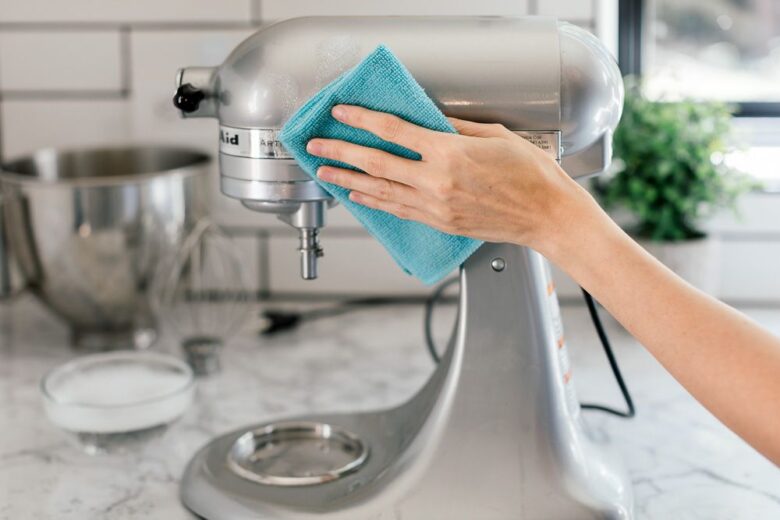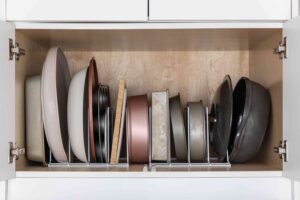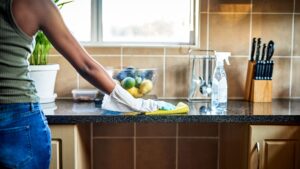Cleaning kitchen utensils is an important part of keeping your cooking area healthy and clean. Regular cleaning of your appliances not only extends their lifespan but also keeps them in good condition. This complete guide discusses many kitchen appliances and gives you tips on how to clean them properly. Whether you’re cleaning your oven or dealing with the daily grime on your stovetop, this guide is designed to give you more confidence in your cleaning skills.
1. Refrigerator
Refrigerators are one of the most used kitchen appliances and therefore need to be cleaned regularly to prevent odor formation and the spread of bacteria.
- Emptying and disconnecting: First, remove everything from the refrigerator and unplug it from the socket. This keeps everyone safe and makes cleaning every corner easier.
- Shelves and drawers: Remove all bins, shelves, and drawers. Wash with soap in warm water, rinse well, and allow to dry.
- Interior Cleaning: To clean the inside, mix two tablespoons of baking soda with a gallon of warm water and wipe it off. Removing stains and removing odors is easy with this solution.
- Exterior Cleaning: To clean the exterior, soak a soft cloth in soapy water and wipe the exterior. To prevent streaks on stainless steel, use a cleaner specifically designed for stainless steel.
2. Oven
Over time, grease and food residue can build up and bake in the oven, making it difficult to remove.
- Self-cleaning function: If your oven has this function, carefully follow the manufacturer’s instructions. This feature makes cleaning easier without having to scrub with your hands.
- Hand Cleaning: To clean by hand, mix baking soda and water into a paste. When you place this pasta in the oven, do not touch the heating element. Wipe off after one night with a damp cloth. If there is any baking soda left, spray it with vinegar. It lathers and wipes off easily.
- Planks: Soak the planks in soapy water for a few hours and then scrub them with a brush or scouring pad.
3. Microwave
Food and grease residue from the microwave can quickly stain your microwave.
- Steam Cleaning: To steam clean, place water and a few lemon slices in a microwave-safe bowl. Cook on high power for a few minutes until the mixture boils and the ramen starts to steam. Do not open the door until it has cooled down. Use a cloth to clean the inside.
- Turntable: Remove the turntable and clean it with soap and water. Make sure it is completely dry before putting it back in the microwave.
4. Dishwasher
Regular cleaning of your dishwasher is important to keep it working properly and to prevent odors.
- Filter: Remove and clean the filter regularly. Place it in soapy water and scrub gently to remove all food.
- Inside: Use dish soap or a cup of white vinegar on the top rack and run a hot wash cycle. This helps remove grease and limescale.
- Door Seal: Use a damp cloth to wipe food or mold from the door seal.
5. Coffee Maker
The limescale and oil left behind by coffee beans can change the taste of your coffee and the operation of your coffee machine.
- Decalcifying: To descale your machine, run a cycle with equal parts water and white vinegar. Then rinse a few times with clean water to remove any residual vinegar.
- Cleaning loose parts: Wash the jug and any loose parts regularly with soapy water to remove coffee oil and other residues.
6. Blender
Sharp blades on blenders can make them difficult to clean.
- Rinse now: Rinse the blender immediately after use to prevent residue from seeping into it.
- Deep Cleaning: To clean your blender, put warm water and a drop of dish soap in the middle. Mix on high speed for a few minutes. Then rinse well.
7. Stovetop
If you have a gas, electric, or induction cooktop, you should keep it clean for safety and performance reasons.
- Daily Cleaning: Wipe your stovetop every day with a damp cloth to remove spills and prevent them from building up.
- Gas stove grates and drip pan: Soak them in soapy water and scrub them to remove food and grease.
- Glass and ceramic surfaces: To prevent scratches, use a cleaner specifically designed for glass or ceramic surfaces. If food becomes hard and burns, use a razor blade to scrape it off. Be careful not to scratch the surface.
8. Toaster
Food crumbs and other small debris can accumulate in the bottom of the toaster, causing a fire.
- Crumb bin: Collect crumbs regularly. Most toasters have a removable tray at the bottom.
- Cleaning the exterior: Wipe the exterior with a damp cloth. Do not use aggressive cleaning agents that can damage the surface.
Conclusion
Regular cleaning of kitchen appliances not only results in a cleaner cooking area but also extends the lifespan of the appliance. By using the ideas and tips in this guide, you can ensure that your kitchen remains clean, safe, and a fun place to cook. Remember that you should always follow the equipment manufacturer’s cleaning instructions to keep it in good condition.
FAQs
1. How do I clean the dishwasher filter?
Refer to the manual that came with your dishwasher for information on how to remove the filter from the bottom of the dishwasher. Rinse it with water to remove dirt. Soak it in soapy water and scrub gently with a soft brush to remove stubborn dirt. Rinse it before putting it back.
2. Can bleach be used to clean my kitchen items?
Bleach is a powerful germicide, but should not be used on all kitchen appliances as it can damage surfaces and leave harmful residues. Be careful when using bleach and only use it on surfaces that are non-porous and easy to clean. For most appliances, it’s best to use a safer cleaning solution such as baking soda, vinegar, or a cleaner made specifically for appliances.
3. What’s the best way to get to the hard fat and food that appliances burn?
A degreaser or a paste of baking soda and water can remove stubborn grease. Leave the paste on your skin for a few hours or overnight. The next day, gently scrub and wash off. Use a scraper to gently remove burnt food from a glass or ceramic stovetop. This will not damage the surface.
4. Is vinegar harmful to kitchen tools?
Most appliances are safe to use with vinegar, but be careful with rubber parts as they can break down over time. For most cleaning jobs, it is safer to mix vinegar with water first. To avoid damage from acidity, rinse after using vinegar.
5. How to clean stainless steel items to prevent streaks?
Use a stainless steel cleaner or a mild detergent diluted with water to clean stainless steel. Apply with a soft cloth and wipe off in the direction of the grain. Dry the device with a clean cloth to prevent water spots and streaks. Microfiber cloths work best when polishing stainless steel.
6. Can chemical cleaners be used to clean the inside of a microwave?
It is best not to use harsh chemicals to clean your microwave. As mentioned, steam cleaning with water and lemon works well and is safe. If you must use a cleaning solution, make sure it is safe for food contact surfaces, and then rinse the inside thoroughly.


